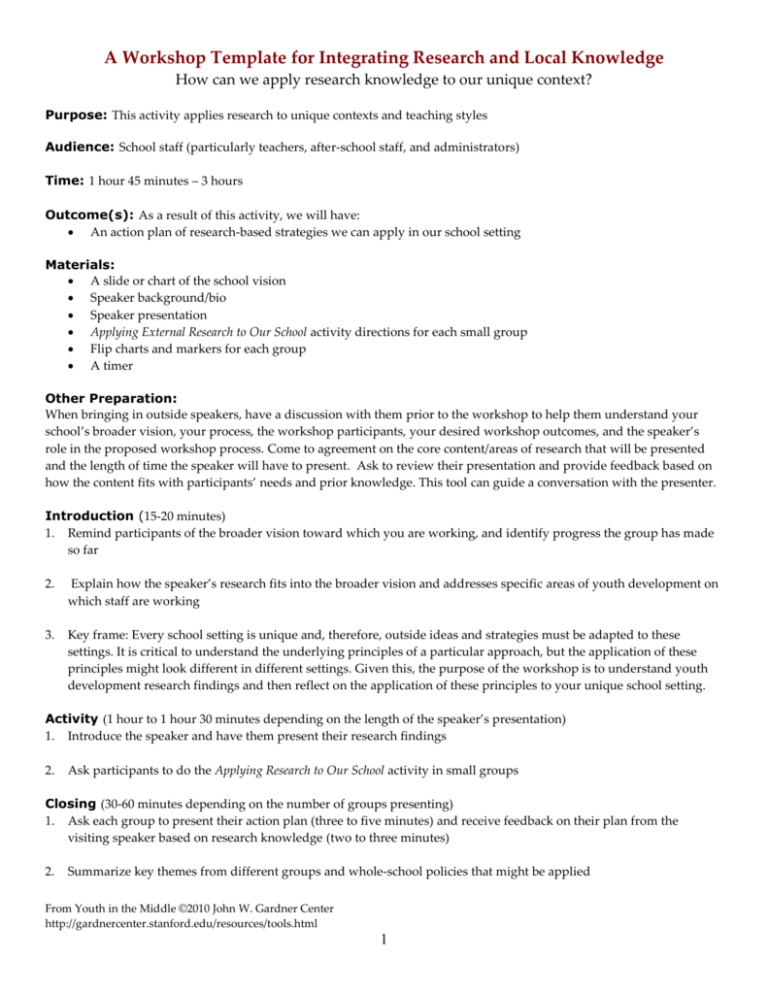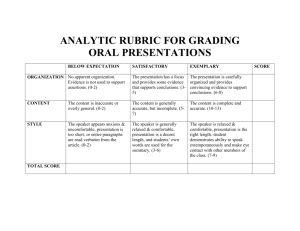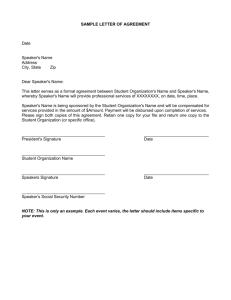Motivation Lit Review - John W. Gardner Center for Youth and Their
advertisement

A Workshop Template for Integrating Research and Local Knowledge How can we apply research knowledge to our unique context? Purpose: This activity applies research to unique contexts and teaching styles Audience: School staff (particularly teachers, after-school staff, and administrators) Time: 1 hour 45 minutes – 3 hours Outcome(s): As a result of this activity, we will have: An action plan of research-based strategies we can apply in our school setting Materials: A slide or chart of the school vision Speaker background/bio Speaker presentation Applying External Research to Our School activity directions for each small group Flip charts and markers for each group A timer Other Preparation: When bringing in outside speakers, have a discussion with them prior to the workshop to help them understand your school’s broader vision, your process, the workshop participants, your desired workshop outcomes, and the speaker’s role in the proposed workshop process. Come to agreement on the core content/areas of research that will be presented and the length of time the speaker will have to present. Ask to review their presentation and provide feedback based on how the content fits with participants’ needs and prior knowledge. This tool can guide a conversation with the presenter. Introduction (15-20 minutes) 1. Remind participants of the broader vision toward which you are working, and identify progress the group has made so far 2. Explain how the speaker’s research fits into the broader vision and addresses specific areas of youth development on which staff are working 3. Key frame: Every school setting is unique and, therefore, outside ideas and strategies must be adapted to these settings. It is critical to understand the underlying principles of a particular approach, but the application of these principles might look different in different settings. Given this, the purpose of the workshop is to understand youth development research findings and then reflect on the application of these principles to your unique school setting. Activity (1 hour to 1 hour 30 minutes depending on the length of the speaker’s presentation) 1. Introduce the speaker and have them present their research findings 2. Ask participants to do the Applying Research to Our School activity in small groups Closing (30-60 minutes depending on the number of groups presenting) 1. Ask each group to present their action plan (three to five minutes) and receive feedback on their plan from the visiting speaker based on research knowledge (two to three minutes) 2. Summarize key themes from different groups and whole-school policies that might be applied From Youth in the Middle ©2010 John W. Gardner Center http://gardnercenter.stanford.edu/resources/tools.html 1 3. Identify specific actions school administrators agree to take on for whole-school action plans, areas where staff need additional help and a specific time when staff will check in on their individual action plans and lessons learned Facilitator Tips: We recommend about 30 minutes for the speaker’s presentation and at least 30 minutes for the activity. When we did this activity, participants wanted more than 30 minutes, but were able to do it in 30 minutes. We also recommend using a timer for the share-outs if time is tight to ensure that every group has equal time to present and receive feedback. It is critical to follow up with school members on the applications of their action plans, as once back in the realities of the school setting it is easy to fall back into old habits and forget lessons learned in the workshop. Even just a few minutes at the start of a staff meeting in which small groups share reflections of actions taken since a workshop can help remind staff of lessons learned and move them toward action. From Youth in the Middle ©2010 John W. Gardner Center http://gardnercenter.stanford.edu/resources/tools.html 2 Applying External Research to Our School Facilitator Directions What would a school that promotes a growth mindset look like? Part I. A School That Applies External Research: Using Brainstorm Protocol (15 minutes) Purpose: To get as many ideas out as possible from all group members without positive or negative judgment or critique Protocol: During open brainstorming, group members call out their ideas as they think of them with one person recording responses on chart paper Other group members refrain from making positive or negative comments about participant contributions Outrageous ideas are welcomed as they may lead to innovative thinking The group continues to brainstorm until time is up or until the group has nothing more to add Directions: 1. Have your team’s recorder record any/all ideas team members have about assumptions/beliefs aligned with the presented research on chart paper. The chart below provides sample prompts that can be used to get the group started. 2. Brainstorm messages, practices, and policies that would be aligned with these assumptions and beliefs. Assumptions and Beliefs In a school that applies the presented research principles, what would school members assume or believe about : - Young people - How young people learn - What motivates young people to learn Messages Given these assumptions and beliefs, what would school members say to youth or to each other? Practices/Policies What policies/practices that are aligned with those assumptions/beliefs would be in place? Examples to think about: - What kind of feedback would students receive on their learning? On their behavior? - What would homework/grading policies look like? - What would discipline policies look like? - How would staff treat each other? Part II. A Plan for Action: Using Round Robin Protocol (15 minutes) Purpose: To allow all participants the opportunity to participate. Protocol Guidelines: - Pose a question to respond to - Each participant has the opportunity to answer the question or pass - Other participants listen without comment or interruption - Those who passed are offered a second opportunity to answer at the end if they wish, but are not required to participate From Youth in the Middle ©2010 John W. Gardner Center http://gardnercenter.stanford.edu/resources/tools.html 3 Directions 1. Ask each group member to look at the team’s brainstorm and to consider from their role at the school: - What could they take and implement on Monday? - What would they need/want more support or help with in order to implement? 2. Have your group recorder record these ideas on a chart (A sample template is provided below) 3. Decide who will report this plan to the larger group (Each group will have three to five minutes to present followed by a few minutes of specific feedback from the speaker) What We Can Start Implementing Monday… What We Need More Help With or Have Questions About… From Youth in the Middle ©2010 John W. Gardner Center http://gardnercenter.stanford.edu/resources/tools.html 4






